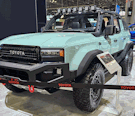The author has 30+ years of automotive experience and has assembled the most extensive collection of symbols and warning lights anywhere (over 1,000!) and can help you open and start any keyless start car with a dead key fob battery. BA, St. Joseph's, ME: MS, RPI, NY
Most commented posts
- Information Displays and Message Centers — 10 comments
Author's posts
Dynamic steering This is a Dynamic Steering Indicator symbol. It is seen when dynamic steering is correcting the steering wheel position or being re-initialized. The steering wheel will be seen to move slightly after the engine is started. Before continuing, is one of these truly your symbol?? If yes, read on below. Otherwise, you can …
Continue reading
Permanent link to this article: https://dashboardsymbols.com/2025/04/dynamic-steering-indicator/
Self driving Dodge introduced its first electric vehicle (EV), the Charger, and on brand, markets the car on its performance. But what stands out in the advertising is the direct hit on the “soulless, self driving sleep pods” presented by other manufacturers. Its a clever tactic aimed squarely at Tesla, although they are not alone …
Continue reading
Permanent link to this article: https://dashboardsymbols.com/2025/04/dodge-ads-hit-at-soulless-self-driving-cars/
Door lock This is a Door Lock Indicator symbol. Oddly, its purpose is to indicate that the doors cannot be opened while the vehicle, which is not something we’ve ever tested in any vehicle. It is seen in black and white and shows a car from the side with a padlock inside. Before continuing, is …
Continue reading
Permanent link to this article: https://dashboardsymbols.com/2025/04/door-lock-indicator/
Honda Prologue or Acura ZDX EV We have added a video to our YouTube channel demonstrating how to open and start 2024 & newer Honda Prologue or Acura ZDX EVs with a dead key fob battery. The vehicles were developed with General Motors (GM), and the EVs carry a lot of GM features, including, unfortunately …
Continue reading
Permanent link to this article: https://dashboardsymbols.com/2025/04/theres-a-new-video-on-our-youtube-channel-open-and-start-a-honda-prologue-or-acura-zdx-ev-with-a-dead-key-fob-battery/
Hidden key hole In 2024 the Chevrolet TRAX was given a new hidden key hole cover that we missed. It has a very BMW-like look cover that is removed using the mechanical key from behind like a Hyundai Santa Fe! We missed it in our recent update but spotted it at the Auto Show and …
Continue reading
Permanent link to this article: https://dashboardsymbols.com/2025/04/chevy-trax-sports-new-hidden-key-hole-cover/
New key hole cap While perusing the Auto Show in New York yesterday, we discovered that the new key hole cap used on the Chevrolet Blazer EV has been added to the Traverse SUV. The same cap is used on the Honda Prologue EV and Acura ZDX EV models that were developed with the help …
Continue reading
Permanent link to this article: https://dashboardsymbols.com/2025/04/chevrolet-adds-their-new-key-hole-cap-to-the-traverse/
Auto Show reflections As has been the case since COVID, the auto show reflections revolve around who didn’t show. Notably, Mercedes made its return for the first time. Stellantis was there in full force as well, including space for a Wagoneer, which a company representative noted is back under the Jeep moniker. They tried to …
Continue reading
Permanent link to this article: https://dashboardsymbols.com/2025/04/2025-new-york-international-auto-show-reflections/




Dodge ads hit at soulless, self driving cars
Self driving Dodge introduced its first electric vehicle (EV), the Charger, and on brand, markets the car on its performance. But what stands out in the advertising is the direct hit on the “soulless, self driving sleep pods” presented by other manufacturers. Its a clever tactic aimed squarely at Tesla, although they are not alone …
Continue reading